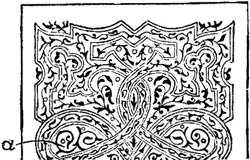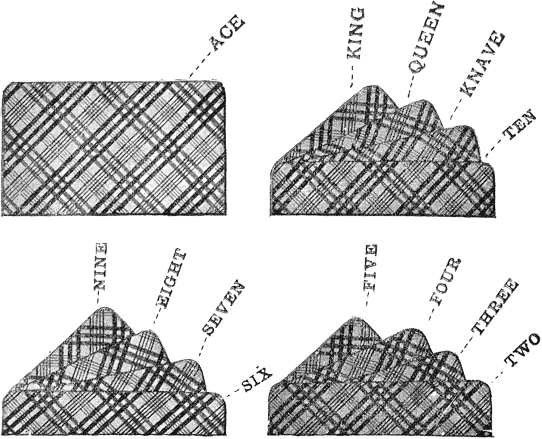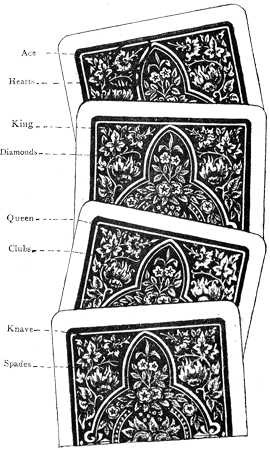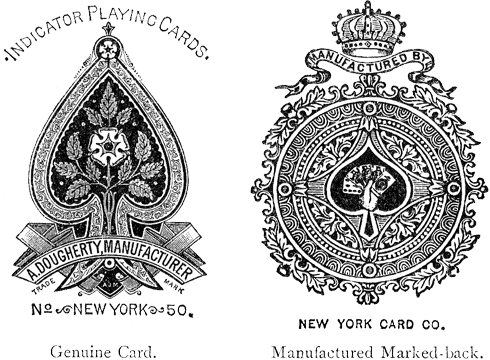
|
foreword to the online edition I. introductory II. common sharpers and their tricks III. marked cards and the manner of their employment IV. reflectors V. holdouts VI. manipulation VIII. the game of faro IX. prepared cards X. dice XI. high ball poker XII. roulette and allied games XIII. sporting houses XIV. sharps and flats
|
SHARPS AND FLATS
CHAPTER III MARKED CARDS AND THE MANNER OF THEIR EMPLOYMENT
§ D -- Cards marked in manufactureGiven the original conception of marked cards, and their practical application to the needs of the sharper, the next step is, obviously, the production of such wares commercially. The desirability of being able to open a new pack of cards and find them ready prepared for use, was too palpable to be overlooked. For a long time the existence of such cards was kept profoundly secret among a very few sharpers, and those 'in the know' reaped a rich harvest. Nowadays, however, these things are, comparatively speaking, 'common objects of the sea-shore.' Fig. 6 is a reproduction of the first pattern ever supplied, ready marked, by the makers. The distinctive marking was arranged by causing the end of the scroll, marked 'a,' to assume various forms, and point in different directions. This card did very well for a time; but the mark was very obtrusive and the pattern became obsolete, being discarded, in fact, for improved forms which were of later invention. FIG. 6 The next step in the way of improvement came with the introduction of the plaid back cards, at one time largely used. It was soon discovered that these lent themselves readily to the purposes of falsification, and the result was the invention of a mark both easy to read and not liable to detection. Like so many other good things, it is marvelous in its simplicity. It is based partly upon modification of the pattern, and partly upon the position occupied by the mark. Fig. 7 illustrates a complete suit of these cards. The higher cards commence with a set of five parallel lines, placed somewhat to the left of the top right-hand corner. The space between the first and second lines is increased to indicate an ace; between the second and third, a king; between the third and fourth, a queen; and between the fourth and fifth, a knave. For the ten, nine, eight, and seven, the pattern is so arranged that the indicating lines terminate at the corner of the card. These being similarly treated, correspond with the four cards of that group. The six, five, four, and three, are respectively given by a similar band, which is so placed that it terminates upon the right hand side of the card, immediately below the top corner. The two is known by the fact of the card being unmarked; that is to say, the lines of all the bands are an equal distance apart, and are not tampered with in any way. The suit is given by a band of lines, terminating some little distance below the top left-hand corner, on the left of the card. The first space (counting from the top) being widened, signifies a diamond; the second, a heart; the third, a club; and the fourth, a spade. If the reader has made the progress in 'sharping' which might reasonably be expected at this stage of his instruction, he should have no difficulty in distinguishing the suit of the ace in fig. 7. It is evidently the ace of clubs. This pattern is of especial value to the man who can deal 'seconds,' as in giving off the 'draft' at poker, and so on, by keeping the pack spread out a little, he can read off the values of the first four or five cards. That is the great advantage in having marks which come quite close to the edge.
FIG. 7 We will conclude this subject of printed backs with a description of one of the best designs ever made (fig. 8). This pattern is particularly easy to read, even at a considerable distance, yet it is certainly not liable to detection by the uninitiated. To anyone who knows the secret, it appears strange that a pack of these cards may be given to a novice for examination, with the information that they are marked, and he will never find anything wrong with them. He may even examine them with a microscope, yet he will see nothing amiss. The reason is that he does not know what to look for. Most probably he will expect to find dots or marks, put on the card by hand. He might thus detect 'scroll work,' examples of which are given further on, though most likely 'shading' would escape his notice from the fact that it is something for which he is not prepared.
FIG. 8 In this instance the distinguishing marks are two in number, one for suit and one for value. These are respectively indicated by variations in the form of the two small sprays in the left hand corner, round which lines have been drawn in the upper card (fig. 8). The lower of the two sprays is caused to show the suit by being curved up or down, or having its termination formed into a suggestion of a spade or a heart, as will be seen on reference to the figure. The upper spray is variously altered to denote the values. Thus:
FIG. 9 Cards marked in printing have of late years been virtually abandoned in America, owing to the fact that they are readily detected, even by those who are utterly unable to discover the marks. The general appearance of the cards is sufficient to show their origin. In the first place, the ink with which the cards are printed is as a rule very inferior; and secondly, the 'ace of spades' has NOT the maker's name upon it. As the maker himself would say' What do you think?' Fig. 10 is a comparison of the ace of spades from a genuine pack with that from a pack of manufactured 'marked backs.' It will be seen that the marked card bears the title of a purely hypothetical 'Card Company.' By referring to the price-lists given towards the end of this book, one finds that the price at which they are quoted is by no means exorbitant, when one bears in mind the risk which the maker runs, and the fact that he has to go to the expense of fifty-two plates for printing the backs, as against the one only which is required for genuine cards. In revenge, and to keep down the cost of production, he uses ink of a very inferior quality to that employed by good firms. Thus, the cards are rendered open to suspicion from the first, and no doubt this has much to do with their falling into disuse. In America their employment is confined chiefly to mining camps, where one may still find 'saloons' which are stocked entirely with this kind of 'paper,' as the cards are called. England, however, must be a fine field for them, as card players here are really so ignorant that the subtle methods of cheating would be thrown away. The best work is not necessary, and the sharp who went to the trouble of adopting it would be simply wasting his substance on the desert air. There is little doubt that these cards are largely used over here. FIG. 10
|
| « marked cards... (...dot and puncture) | marked cards... (shading and tint-marking) » |
home | introduction | book content | links | advertising | contact




